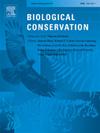人工繁殖的反常效应?东部地狱蝠(Cryptobranchus a. alleganiensis)的联邦非保护地位
IF 4.9
1区 环境科学与生态学
Q1 BIODIVERSITY CONSERVATION
引用次数: 0
摘要
一些科学家担心,将人工繁殖作为一种保护工具会无意中转移对栖息地保护的关注和资源。美国鱼类和野生动物管理局于 2019 年 4 月做出决定,根据《濒危物种法》,东部地狱蝾螈--一种数十年来经历了种群数量下降的巨大水生蝾螈--不需要被列为濒危或受威胁物种,这一案例证明了这种担忧是正确的。本文探讨了这一案例的历史、由此引发的诉讼、社会背景以及列入决定的悖论,其中善意的人工饲养项目的愿望被用作否认需要额外保护的借口,这一结果最好从生物多样性政策和法律中的反常效应和意外后果的讨论中加以理解。本文章由计算机程序翻译,如有差异,请以英文原文为准。
A perverse effect of captive propagation? The federally unprotected status of the eastern hellbender (Cryptobranchus a. alleganiensis)
Some scientists worry that the use of captive propagation as a conservation tool can unintentionally divert attention and resources from habitat protection. This concern was vindicated in the case of the U.S. Fish and Wildlife Service's April 2019 decision that the eastern hellbender, a giant, aquatic salamander that has experienced population declines for decades, does not warrant listing as endangered or threatened under the Endangered Species Act. This paper examines the case history, resulting lawsuit, social context, and paradoxes of this listing determination, where the aspirations of well-intentioned captive rearing programs were used as a pretext for denying the need for additional protections, a result that is best understood in light of discussions about perverse effects and unintended consequences in biodiversity policy and law.
求助全文
通过发布文献求助,成功后即可免费获取论文全文。
去求助
来源期刊

Biological Conservation
环境科学-环境科学
CiteScore
10.20
自引率
3.40%
发文量
295
审稿时长
61 days
期刊介绍:
Biological Conservation is an international leading journal in the discipline of conservation biology. The journal publishes articles spanning a diverse range of fields that contribute to the biological, sociological, and economic dimensions of conservation and natural resource management. The primary aim of Biological Conservation is the publication of high-quality papers that advance the science and practice of conservation, or which demonstrate the application of conservation principles for natural resource management and policy. Therefore it will be of interest to a broad international readership.
 求助内容:
求助内容: 应助结果提醒方式:
应助结果提醒方式:


